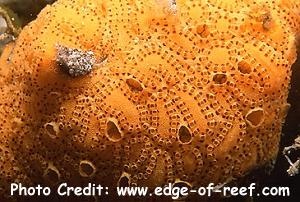
By Bob Goemans


Most sea squirts are found on reef drop-offs and/or under overhangs, with some found at the base of corals. Occasionally, they are found attached to live rock or corals entering the aquarium. They are called 'sea squirts' because a jet of water is expelled when they contract. Very few of these beautiful creatures are sustainable for more than a few months. And in fact, their general life span is generally no longer than a year.
Many 'tunicates' have male and female reproductive organs, therefore produce both sperm and eggs. Following a free swimming or planktonic larval stage the adults live a sessile lifestyle. Their bodies are encased in a protective tunic, hence the name 'tunicate.' This supportive enclosure may be smooth or leathery, and is usually attached to firm substrate, e.g., rock, seaweed, or even other animals.
There are two openings in the tunic, one is often larger than the other. The larger one, called the buccal siphon is where beating cilia draw in water. It enters a chamber called the pharyngeal basket, which filters the water for oxygen and foodstuffs. The filtered water then is expelled through the smaller opening called the atrial siphon. Food particles are mixed with mucus and drawn into the oesophagus and digested. Resulting waste products also leave through the smaller opening.
Unfortunately they require heavy concentrations of suspended food particles and/or bacteria laden waters. And as noted above, have a very short life span, about one year and sometimes far less. However, there are some species occasionally seen in the trade that are extremely colorful and attract hobbyists. Only those willing to provide for their demanding level of care should attempt keeping them in closed systems. Actually, 99.9% should be left in the wild.
For those that want to maintain them in aquaria, these creatures require numerous feedings per day of live and/or preserved commercial phytoplankton/zooplankton products or that of animal and plant powders that produce suspended products in the bulk water.
The following are mostly shown only to depict their beauty. Please think twice about removing these beautiful creatures from the wild! And for more information about these pretty creatures, read "Reef Invertebrates, An Essential Guide to Selection, Care and Compatibility" by Anthony Calfo & Bob Fenner, ISBN 0-9672630-3-4, and checkout its 'review' posted in the Review section of this website.
FYI: There are few in this overall Grouping that show up in the aquarium trade, with all best maintained in shaded areas with low water flow.
Therefore, as noted in other areas of this Species Library, some species will contain suggested PAR levels and/or Water Motion (WM) levels.
As for water motion, I've decided to relate it to the visible intensity of water motion on that of a long tentacle anemone. No visible tentacle motion is '0,' whereas a slight movement of some tentacles is '1.' If all the tentacles are gently swaying in the current it is '2.' If all tentacles are moving fairly fast and bouncing into each other it is '3.' Should all tentacles be driven with such force they are extended in one direction or unable to sway back to their central position it's '4.'
You will see them as - PAR - XXX & WM - X. Hopefully you'll find this quite helpful.
© 2012 Bob Goemans. All rights reserved.
The material on this site may not be reproduced, distributed, transmitted, cached or otherwise used, except with the prior written permission of Bob Goemans.
